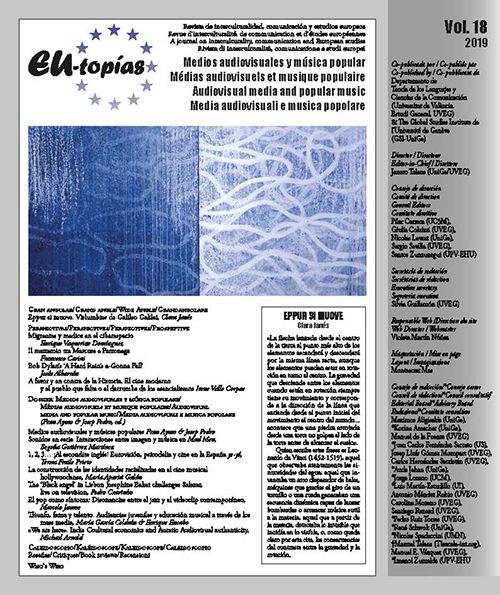We are here». Indie cultural economics and auratic audiovisual authenticity
DOI:
https://doi.org/10.7203/eutopias.18.16849Keywords:
Pony Bravo, rock, blues, flamenco, cultural economics, audiovisual autenthicity Abstract
Abstract
This article investigates the cultural economics of the international indie scene with a special focus on the Seville-based four-piece indie neoflamenco band named Pony Bravo and specifically on the group’s prolific sonic and graphic montage visionary, Daniel Alonso Mallén. Pony Bravo draws on a variety of music traditions, connecting the sound and rhythm of the various marginalized «souths»: U.S. southern roots rock and blues, Andalusian rock, flamenco, African and Jamaican rhythms, etc. As they play with these traditions, the group uses their platform to fight for the right to do so: to borrow, to sample, to quote, to remix, to collage, to recycle the rhythms, melodies, harmonies, lyrics, ideas, and images of those creators and tricksters that came before them. With help from Walter Benjamin’s dichotomy between auratic and nonauratic artforms, this article explores the inflation of subcultural capital in indie music (through fan assimilation of nonauratic knowledge) and the elevation of the auratic live artifact as a reaction by those who would keep that currency in check. Daniel Alonso elevates the auratic moment captured as content within the nonauratic form of the archived online promotional poster. He simultaneously champions the demise of all forms of the nonauratic in his embrace of a sort of cultural capital socialism vis-à-vis creative commons (instead of intellectual property) licensing and his antagonistic stance toward the institutions (the SGAE) and legislation (la ley Sinde) that fight for the protection of national and international artists’ IP rights.
 Downloads
Downloads
 References
References
Alonso Mallén, Daniel (2008), «El rayo», Si bajo de espalda no me da miedo (y otras historias), El Rancho.
Benjamin, Walter (2008), «The Work of Art in the Age of Its Technological Reproducibility», Michael W. Jennings, Brigid Doherty and Thomas Y. Levin (eds.), Edmund Jephcott, Rodney Livingstone, Howard Eiland, and Others (trans.), The Work of Art in the Age of Its Technological Reproducibility and Other Writings on Media, Cambridge, The Belknap Press of Harvard University Press, pp. 19-55.
Cádiz, Beni de (2006), «Tormento de mis tormentos», Bulerías y fandangos, Novoson.
Ceballos, Diego J. (n.d.) «Pony Bravo», Tertuliaandaluza.com.
Doran, John (2005), «Soundsystem and Vision», Ireallylovemusic.co.uk. July 1.
Eco, Umberto & Weaver, William (trans.) (1986), Travels in Hyperreality, New York: MBJ.
«Entrevista a Pony Bravo (Feb 2010, Barcelona)», Youtube.com.
Fitzpatrick, Rob (2011), «When Bands Fall off Cliffs», Guardian.co.uk. October 27.
Fonarow, Wendy (2006), Empire of Dirt: The Aesthetics and Rituals of British Indie Music, Middletown: Wesleyan University Press.
Gallardo, José M. (2010), «Pony Bravo. Dadás en el rancho», Musica.heineken.es. November 2.
Guerola, Abel (n.d.), «Reseña: Un gramo de fe de Pony Bravo», Tertuliaandaluza.com.
Jennings, David (2007), Net, Blogs and Rock ‘n’ Roll: How Digital Discovery Works and What It Means for Consumers, Creators and Culture, London: Nicholas Brealey Publishing.
Jennings, Michael W (2008), «The Production, Reproduction, and Reception of the Work of Art», Michael W. Jennings, Brigid Doherty and Thomas Y. Levin (eds.), Edmund Jephcott, Rodney Livingstone, Howard Eiland, and Others (trans.), The Work of Art in the Age of Its Technological Reproducibility and Other Writings on Media, Cambridge, The Belknap Press of Harvard University Press, pp. 9-18.
Murphy, James (2002), «Losing My Edge», Losing My Edge, DFA Records.
Pato, Ignacio (2010), «Un gramo de fe», Mondosonoro.com. October 29.
Peña, Pablo (2013), «Mi DNI», De palmas y cacería, BCore.
Txopo (2010), «Mejores discos nacionales de 2010», Notedetengas.es. December 29.
Downloads
Published
How to Cite
-
Abstract353
-
PDF189
Issue
Section
License
![]()
The authors conserve the copyright. All content published in EU-topías. Journal of interculturality, Communication, and European Studies are subject to the license Creative Commons Attribution-NonCommercial-ShareAlike 4.0 license. The full text of the license can be found at <http://creativecommons.org/licenses/by-nc-sa/4.0>
They may be copied, used, disseminated, transmitted and publicly displayed, provided that:
- The authorship and original source of the publication is cited (journal, publisher and URL of the work).
- They are not used for commercial purposes.
- The existence and specifications of this license of use are mentioned.
It is the responsibility of the authors to obtain the necessary permissions for images that are subject to copyright.



